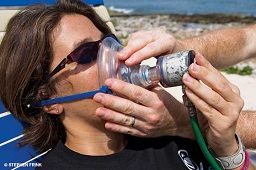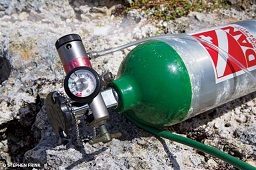Oxygen accounts for 21 percent of the air we breathe and is critical for our survival. When we inhale, oxygen enters alveoli (air sacs) in the lungs, where it crosses a thin membrane into the capillaries and binds to the hemoglobin of red blood cells. The blood then transports oxygen to the rest of the body. Administering oxygen is essential first aid for people experiencing symptoms of decompression illness (DCI). Dive-accident victims benefit from the use of oxygen in two fundamental ways. First, breathing pure oxygen speeds the washout or elimination of inert gas (i.e., nitrogen and, for trimix divers, helium). Second, areas of the body with reduced oxygen supplies due to compromised blood flow may receive enough oxygen to minimize or prevent tissue injury.
Understanding Partial Pressure
A helpful concept for better understanding the use of oxygen in diving and dive emergencies is partial pressure. The partial pressure of a gas is the fraction of that particular gas in a gas mix multiplied by the ambient pressure. At sea level — which is 1 atmosphere absolute (ATA) of pressure — the oxygen partial pressure (P2) of air is 0.21 (21 percent oxygen x 1 ATA), and the PO2 of 100 percent oxygen is 1.0. At a depth of 66 feet (3 ATA), the PO2 of air is 0.63 (21 percent oxygen x 3 ATA), and the PO2 of 100 percent oxygen is 3.0. A PO2 that is either too low or too high can be dangerous to humans. Loss of consciousness due to hypoxia is likely at a PO2 below about 0.16. A PO2 in excess of about 1.5 puts a diver at risk of central nervous system (CNS) oxygen toxicity, which can lead to convulsions and drowning.
Means of Administsration
Devices used to deliver oxygen include demand valves, nonrebreather masks (NRBs), bag-valve masks, manually triggered ventilators and nasal cannulas. A demand valve is similar to a second-stage scuba regulator in that it delivers gas only when the patient inhales. With a well-sealed mask, a demand valve can deliver about 95 percent oxygen. It is designed for conscious, alert patients whose respirations are strong enough to engage the flow of oxygen.

Nonrebreather masks provide a constant high flow of oxygen. The flow rate of an NRB is manually adjustable, and the rate is usually set between 10 and 15 liters per minute. A high flow rate does not necessarily equate to more effective treatment, however. To avoid wasting oxygen, set the flow rate just high enough to prevent the reservoir bag from collapsing fully when the patient inhales. Take care to ensure the mask maintains a good seal for as long as it’s used.
Bag-valve masks and manually triggered ventilators are used to administer positive-pressure ventilations of oxygen to people who are not breathing on their own. Caregivers accomplish this with a bag-valve mask by squeezing a gas reservoir bag and with a manually triggered ventilator by pressing a button that delivers a safe volume of gas.
Nasal cannulas consist of two small plastic prongs that fit into the nostrils and continuously blow oxygen. Inspired fractions of oxygen are elevated only minimally compared to breathing air, so this method of oxygen administration provides little therapeutic benefit to injured divers.
Asymptomatic Divers
Callers often ask DAN® if they should administer oxygen to a diver who reported a rapid ascent but has no symptoms. There is no simple or one-size-fits-all answer to this. Factors to consider include the diver’s decompression stress (missed mandatory decompression, significantly deep or long dives or many dives in a series) as well as the true speed of the ascent and the distance to definitive medical care.
Giving people oxygen is not harmful, but providing it purely as a preventive measure raises difficult questions about how long to administer it, the goal of treatment and in what circumstances a medical evaluation is warranted. Consider the available supply, and recognize that by initiating oxygen administration you have acknowledged that an incident has or is likely to occur. The patient should not do any more diving that day and should be monitored for 24 hours. DAN is available for consultation in these situations.
Use What You Have
Divers also ask DAN if they should set the flow rate lower than 10 to 15 liters per minute to make a limited supply of oxygen last longer. This is a reasonable question, but remember why oxygen therapy is used for divers: The goal is to create a partial pressure gradient to promote the elimination of inert gas (nitrogen). The way to achieve this goal is to deliver the highest concentration of oxygen possible. Therefore, the priority should be to administer oxygen at the maximum possible concentration until you transfer care or supplies run out.
Oxygen Toxicity
From time to time DAN receives calls from concerned dive buddies who are hesitant to administer oxygen to a diver who might have experienced CNS oxygen toxicity at depth. However, once a diver is on the surface, there is no reason to withhold oxygen. Even if the symptoms noted at depth were actually the result of CNS toxicity, administering oxygen is still recommended, and it will not harm the diver.

Some people mistakenly believe that if a diver is breathing oxygen from a cylinder at surface pressure, air breaks should be used to prevent CNS oxygen toxicity. As well intentioned as that may be, no air breaks are necessary; oxygen should be provided without interruption. Air breaks are employed during some hyperbaric-chamber treatments to minimize the risk of CNS toxicity. However, such breaks are not necessary for divers treated at the surface because CNS toxicity is not a concern when the maximum PO2 is 1 ATA.
Breathing pure oxygen can irritate the lungs (pulmonary oxygen toxicity), but at sea level pulmonary toxicity (often manifested by chest discomfort or a burning sensation in the lungs) requires 12 to 16 hours of continuous therapy. While this timeline may be shortened when the PO2 is greater than 1, such symptoms are rare, and oxygen administration should not be withheld or arbitrarily stopped in an attempt to prevent symptoms that take many hours to present.
Emergency oxygen administration remains the cornerstone of treatment for acute DCI. By keeping your oxygen unit in good working order and practicing deployment and administration regularly, you will be prepared to provide effective care. Remember, the person in need may be you.
© Alert Diver — Q4 Fall 2012